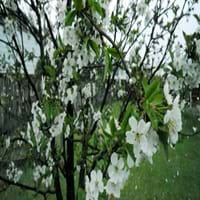Life Span
Perennial
Perennial
Type
Flowering Plants, Fruits, Trees
Fruit
Origin
Central America, Europe, North America
Western Asia
Types
Not Available
Büttnera Czerwona, Hedelfinger Sweet Cherry
Number of Varieties
Not Available
Habitat
Hedge, Scrubs, Woods
Woodland Garden Canopy
USDA Hardiness Zone
4-8
5-8
AHS Heat Zone
Not Available
8-1
Sunset Zone
Not Available
2a, 2b, 6, 7, 14, 15
Habit
Not Available
Upright/Erect
Flower Color
White
Not Available
Flower Color Modifier
Not Available
Bicolor
Fruit Color
Yellow
Not Available
Leaf Color in Spring
Dark Green
Not Available
Leaf Color in Summer
Green
Not Available
Leaf Color in Fall
Brown, Green, Light Yellow
Not Available
Leaf Color in Winter
Not Available
Not Available
Leaf Shape
Oblong
broad, flat
Plant Season
Summer
Spring, Summer, Fall
Sunlight
Full Sun, Partial shade
Full Sun, Partial Sun
Growth Rate
Medium
Medium
Type of Soil
Loamy
Clay, Loam, Sand
The pH of Soil
Neutral
Acidic, Neutral
Soil Drainage
Well drained
Well drained
Bloom Time
Fall, Summer
Spring
Tolerances
Drought
Not Available
Where to Plant?
Ground
Ground
How to Plant?
Grafting, Seedlings, Transplanting
Semi-hardwood and hardwood cuttings
Plant Maintenance
Medium
Medium
Watering Requirements
Medium
Water 1 in. per week during the active growing period, Water more in summer
In Summer
Lots of watering
Lots of watering
In Spring
Moderate
Moderate
In Winter
Average Water
Average Water
Soil pH
Neutral
Acidic, Neutral
Soil Type
Loamy
Clay, Loam, Sand
Soil Drainage Capacity
Well drained
Well drained
Sun Exposure
Full Sun, Partial shade
Full Sun, Partial Sun
Pruning
Prune when plant is dormant, Remove dead or diseased plant parts
Remove dead branches, Remove thin branches
Fertilizers
All-Purpose Liquid Fertilizer
A 10 pound bag of 16-4-8 fertilizer
Pests and Diseases
Aphids, Curculio occidentis, Japanese Beetles, Leaf Rollers, Leafminer, Mites, Red blotch, sawflies, Scale, Stink bugs
Aphids, Borers, Mites
Plant Tolerance
Drought
Drought
Flower Petal Number
Single
Not Available
Foliage Texture
Medium
Not Available
Foliage Sheen
Matte
Not Available
Attracts
Not Available
Birds, Flies
Allergy
Digestive Problems, Respiratory problems
Mild Allergen, Vomiting
Aesthetic Uses
Showy Purposes
Beautification, Used in parkland
Beauty Benefits
Beautiful Skin
Anti-ageing, Good Cleanser, Good for skin, Promotes Healthy Hair
Environmental Uses
Food for birds
Air purification
Medicinal Uses
Anthelmintic, Antibacterial, Astringent, Hypnotic, Laxative, Refrigerant
Antitussive, Astringent, Diuretic, Tonic
Part of Plant Used
Fruits
Fruits, Seeds
Other Uses
Edible syrup, Jam, Jelly, Used As Food
Used for making green dye, Wood is used for making furniture
Used As Indoor Plant
No
No
Used As Outdoor Plant
Yes
Yes
Garden Design
Not Available
Edible, Fruit / Fruit Tree, Shade Trees, Topiary / Bonsai / Espalier
Botanical Name
Malus sylvestris
PRUNUS avium
Common Name
European crab apple
Sweet Cherry
In Hindi
european crab apple
मीठी चेरी
In German
Der Holzapfel, Europäischer Wildapfel
Süße Kirsche
In French
Le Boquettier, le Pommier sauvage ou Pommier des bois
Cerise sucrée
In Spanish
Malus sylvestris, el Manzano silvestre, manzano silvestre europeo
Cereza dulce
In Greek
Ευρωπαϊκή μήλο καβουριών
γλυκό κεράσι
In Portuguese
Malus sylvestris
Cereja doce
In Polish
Jabłoń dzika
Słodka Wiśnia
In Latin
european crab apple
dulcis cerasus
Phylum
Magnoliophyta
Magnoliophyta
Class
Magnoliopsida
Magnoliopsida
Clade
Angiosperms, Eudicots, Rosids
Angiosperms, Eudicots, Rosids
Tribe
Not Available
Amygdaleae
Subfamily
Not Available
Amygdaloideae
Number of Species
Not Available
Not Available
Difference Between European Crab Apple and Sweet Cherry
If you are confused whether European Crab Apple or Sweet Cherry are same, here are some features about those plants to help you choose better. Many people think that these two plants have the same characteristics, but one can see European Crab Apple and Sweet Cherry Information and learn more about it. Fertilizers required for proper growth of European Crab Apple are All-Purpose Liquid Fertilizer, whereas for Sweet Cherry fertilizers required are A 10 pound bag of 16-4-8 fertilizer. Hence, one should know the basic difference between European Crab Apple and Sweet Cherry if you are planning to have them in your garden to enhance its beauty.
<
Flowering PlantsImportance of European Crab Apple and Sweet Cherry
Want to have the most appropriate plant for your garden? You might want to know the importance of European Crab Apple and Sweet Cherry. Basically, these two plants vary in many aspects. Compare European Crab Apple and Sweet Cherry as they differ in many characteristics such as their life, care, benefits, facts, etc. Every gardener must at least have the slightest clue about the plants he wants to plant in his garden. Compare their benefits, which differ in many ways like facts and uses. The medicinal use of European Crab Apple is Anthelmintic, Antibacterial, Astringent, Hypnotic, Laxative and Refrigerant whereas of Sweet Cherry is Antitussive, Astringent, Diuretic and Tonic. European Crab Apple has beauty benefits as follows: Beautiful Skin while Sweet Cherry has beauty benefits as follows: Beautiful Skin.
Compare Facts of European Crab Apple vs Sweet Cherry
How to choose the best garden plant for your garden depending upon its facts? Here garden plant comparison will help you to solve this query. Compare the facts of European Crab Apple vs Sweet Cherry and know which one to choose. As garden plants have benefits and other uses, allergy is also a major drawback of plants for some people. Allergic reactions of European Crab Apple are Digestive Problems and Respiratory problems whereas of Sweet Cherry have Mild Allergen and Vomiting respectively. Having a fruit bearing plant in your garden can be a plus point of your garden. European Crab Apple has showy fruits and Sweet Cherry has showy fruits. Also European Crab Apple is flowering and Sweet Cherry is not flowering . You can compare European Crab Apple and Sweet Cherry facts and facts of other plants too.





